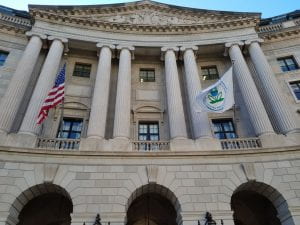I wasn’t sure what to expect when I entered Derby Hall in 2008, yet I suspected and hoped it would be a transformative experience. I found faculty research grounded in the physical and social sciences both intriguing and daunting, especially since I earned an undergraduate degree in the natural sciences. And I knew that OSU’s Geography program was long-respected and highly ranked in the field. The next two years–plus an additional four years spent earning my PhD–proved to be an excellent fit and provided me with a strong foundation for my academic career and personal life.
My Geography courses were demanding and rigorous, yet flexible enough to accommodate my research interests. My graduate student peers provided much needed levity in the form of office banter, trivia nights and High Street outings, and testing my (inferior) ping pong and badminton skills. And Staff like Diane Carducci and Colin Kelsey were warm and supportive. Friendships and professional networks developed during that time remain strong to this day.
My advisors Becky Mansfield and Kendra McSweeney supported my multidisciplinary pursuits in History, Rural Sociology, and Public Health. They, along with Nancy Ettlinger, Joel Wainwright, and Cathy Rakowski, among others, encouraged me as I developed research projects in Nicaragua and Latin America. As a Teaching Assistant, graduate students Eveily Freeman and Jessica Barnes modeled excellent undergraduate teaching and opened my eyes to online learning, which has proven immensely helpful in the last two years.

SUNY Old Westbury students and I (lower right) visit a coffee farm near Matagalpa, Nicaragua, in March 2018.
Ultimately, my years in Derby Hall prepared me for my current position as an Assistant Professor of Public Health at SUNY Old Westbury. My broad background and pedagogical training suited my current department’s diverse liberal arts courses: Introduction to the Social Determinants of Health, Global Health, and Research Methods, to name a few. The Environmental Justice course that I developed is heavily inspired by the Nature and Society courses that I took in Derby Hall. I am particularly proud of having taken undergraduate students to Nicaragua and Bolivia; if travel restrictions ease in time, I’ll add Cuba to that list this summer!

Community celebration at Sure We Can, a not-for-profit that supports informal recyclers and advocates for their well-being in Brooklyn, New York, where I serve as Co-Chair of the Board of Directors.
Finally, my time at OSU helped me realize the importance of community. Ed Malecki, Ola Ahlqvist, Alvaro Montenegro, and Max Woodworth regularly ate lunch with graduate students in the lounge, and Morton O’Kelly, Kendra McSweeney, and Becky Mansfield hosted get-togethers in their homes. Importantly, these conversations and gatherings gave me an idea of what work-life balance and parenthood as an academic might look like. (My first child was born in December 2021!) Also, they reinforced the importance of building community beyond Derby Hall and academia, and the possibilities that arise from scholar-activist engagement.
In sum, my time in Derby Hall was truly transformative, and I am happy to be part of OSU Geography’s storied history!
Chris Hartmann, MA (2010), PhD (2016)





